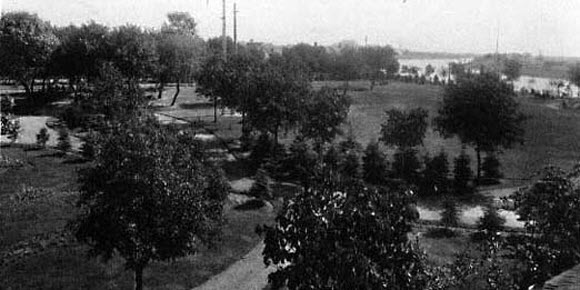by Bruce Cherney (part 8 of 8)
Not only had Winnipeg Alderman A.A. Heaps changed his mind about selling half of Victoria Park to Winnipeg Hydro, but so had the editorial board of the Winnipeg Tribune.
On March 2, an editorial appeared in the newspaper stating: “The Tribune from the outset opposed the invasion of Victoria Park. City Hydro however was able to make out an unanswerable case for the location of its standby plant in the near neighborhood of the high pressure plant (James Avenue Pumping Station, opened in 1907). Business considerations involved in the question entirely outweighed the sentimental side of it.”
The newspaper praised Heaps for obtaining another larger park for just $48,000 in exchange for ceding just four-fifths of an acre of Victoria Park.
According to the newspaper’s editorial, what Heaps achieved was “precisely the way a good business concern would set about to buy a piece of property.”
What the newspaper didn’t mention was that Heaps, besides being a self-proclaimed socialist, had started an insurance agency for Great-West Life. As such, he was well-versed in the “ways” of the business world.
The new Norquay Park, named after former Manitoba Premier John Norquay (1841-89), opened in July 1923.
Once Winnipeg Hydro had purchased half of Victoria Park, it became inevitable that the other half would be acquired by the city-owned utility, since the land was needed to build a larger complex. Plans were going ahead for a combination steam-heating and standby electrical plant.
On March 10, 1924, city council gave its final approval for the remainder of Victoria Park’s purchase by hydro for $49,075.
By the end of the year, the standby plant and central steam-heating plant (referred to as the Amy Street Steam Heating Plant) had been built.
To mark the opening of both facilities, an invitation-only banquet was held on November 12 on the generator floor of the standby plant. During the banquet, frequent mention was made that the “plant represented a combination which made it the greatest plant in the world of its kind.”
“In all my experience of 25 years,” J.G. Glassco, the head of the city-owned electrical utility, told the guests at the banquet, some of whom were from Eastern Canada and the United States, “I have never seen such an intricate piece of work grow together so smoothly and with so little friction. It is only 13 months since we turned the first sod in Victoria Park, and now we are supplying steam heat to a large number of customers.”
Of course, once the first sod at Victoria Park was turned in 1923 for the new facility, it effectively doomed the remaining portion of the tiny park devoted to public use in the city’s downtown.
Years after Victoria Park had disappeared from the city’s landscape, Heaps said it was a source of considerable satisfaction to him that the combination standby and steam-heating plant was approved while he chaired the public utilities committee and parks board.
“In 1923,” he stated in a September 1, 1931, Tribune special feature about Winnipeg Hydro, “the old Victoria park, east of Main st., where the standby and heating plant are now situated, was getting to look less and less park-like owing to the increasing industrialization of the neighborhood. The sale of the park to Hydro, although criticized severely at the time, has amply proved itself a wise move ...
“With the proceeds obtained from the sale of Victoria park on the Red river bank. This new park was a tremendous boon to one of the most overcrowded sections of the city.”
It seems surprising that Heaps argued against a free public park in a heavily industrialized section of the city that provided a respite from the dreary conditions experienced by poorly-paid workers and the impoverished children of the area.
Given his political affliation, he should have emphasized that such a setting actually contributed to its viability rather than being seen as a detriment.
Further justification for the sale of Victoria Park, according to Heaps, was that there was enough money left over to acquire the Windsor Park municipal golf course.
William Douglas wrote in an article entitled, Winnipeg’s Parks (Manitoba Transactions, 1957-58 season), that he personally never forgave city council for selling Victoria Park to Winnipeg Hydro.
In 2002, the city-owned utility was sold and incorporated into Manitoba Hydro.
“Where once existed, in the very heart of Winnipeg, a real beauty spot, on the bank of the Red River,”wrote Douglas, “we now find a giant commercial building, smoke stacks, coal dump, smoke and soot.”
His article included information about the early history of the of land that eventually contained the park, which was originally deeded by Sir George Simpson of the Hudson’s Bay Company to Alexander Ross in 1825. A quite small section of the original 200-acre Colony Gardens land grant became Victoria Park in 1893.
“Perhaps the utilitarian instincts of the City Fathers far outweighs their perspective when it comes to offset dollars against an historic link with yesterday to our community,” Douglas speculated as being the reasoning behind the sale of Victoria Park to Winnipeg Hydro.
Thirty years after the steam-heating plant came online, many businesses began converting to gas-fired heating systems. And new provincial environmental regulations meant coal-fired heating systems were too polluting.
The plant became uneconomical and it was decommissioned in June 1990. The plant with its smoke-belching stacks — which so greatly offended Douglas — was demolished and a portion of the property was incorporated into Waterfront Drive.
Where another portion of Victoria Park once stood, there is now a condominium complex along Waterfront Drive, between Amy Street and James and Pacific avenues.



